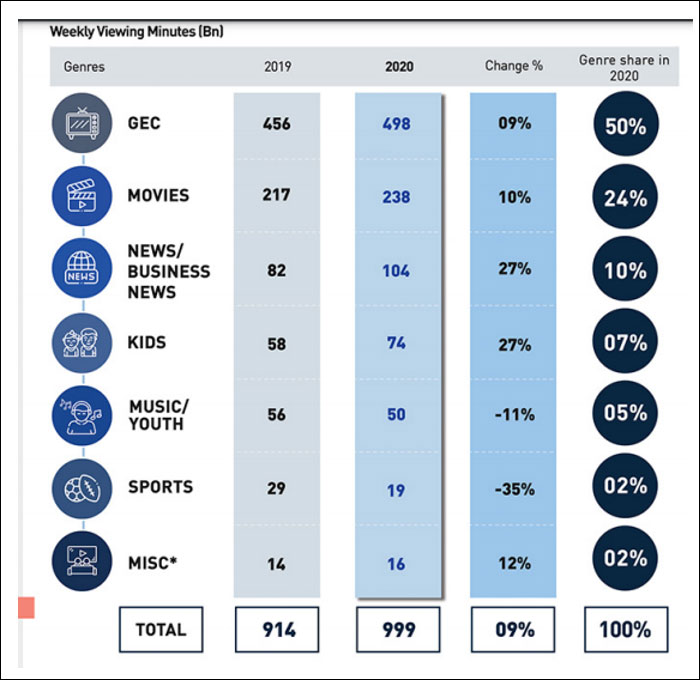MUMBAI: The television industry witnessed unprecedented highs and lows in 2020, or the year that shall not be named. From record viewership, new category leaders, to diminished ad revenue and stiff competition from upstart OTT players – TV Land saw it all and emerged stronger for it. Now, the Broadcast Audience Research Council (BARC) India has come out with the third edition of its Yearbook titled The Year After Two Thousand & Nineteen that encapsulates this tumultuous period for television and its viewers.
The Yearbook offers exclusive insights and extensive data on “What India Watched” in 2020 along with trends across the pandemic struck months; with a special focus on four distinct phases, viz, Pre-Covid, Covid: During Lockdown, Covid: Unlock, and Year Ender.
Covid2019 forced people to stay confined to their homes starting 25 March 2020. The lockdown made viewers turn to their favourite mode of entertainment and news – television.
TV played a significant role in keeping people connected with the outside world during the lockdown. Consequently, TV viewership witnessed a growth of 23 per cent during mid-March to June (week 11-26) as compared to the January to early March period (week 1-10).
Overall, TV viewership grew by nine per cent, driven by ATS (average time spent) clocking four hours two minutes daily in 2020 from three hours 42 minutes in 2019. Viewership surged for GECs, news, movies and kids channels, largely due to the Covid2019 lockdown. The report has also mentioned that due the pandemic, live sports events and sports viewership dipped for most of the year.
With a clutch of Hindi GEC free-to-air returning to the DD Free Dish platform in 2020 after about a year’s gap, audiences transitioned from the music/youth genre. This, followed by music, youth channels going off air, led to viewership decline in the genre.

The report also suggested that all genres experienced a decline in ad volumes, with the exception of movies genres, which grew by nine per cent. Non-prime time emerged as the new prime time. The share of non-prime time viewing in total TV viewership rose from 51 per cent in 2019 to 53 per cent in 2020.
Week 12 garnered the highest viewership of 260 billion viewing minutes, according to BARC. Re-runs of mythological shows by Doordarshan were a smashing success, leading to a 68 per cent growth in the network’s viewership in 2020 as compared to 2019. Moreover, DD’s share in all-India TV viewing increased from 1.2 per cent in 2019 to 1.8 per cent in 2020. Advertisers quickly leveraged DD’s spike in viewership, leading to a 31 per cent uptick in advertising volumes on DD channels as compared to 2019.
The viewership contribution of mythological shows to the Hindi GEC genre spiked from a mere 14 per cent pre-Covid2019 to 43 per cent by week 15, 2020.

BARC India CEO Sunil Lulla said, “The year was a consolidation and reaffirmation year for television in India. It was marked by a substantial increase in TV viewership with total TV growing by nine per cent and ad volumes experiencing a staggering growth of 34 per cent in the second half. 2020 reaffirmed the strength of television as a medium in India amongst both viewers and advertisers, proving TV is indeed the screen of choice for the household. TV continues to grow with regional markets gaining prominence. BARC India will continue to work towards our vision, to always be the trusted source of authentic measurement and reporting of ‘What India Watches’.”
Following are a few highlights from What India Watched in The Year After Two Thousand & Nineteen:
• Non-prime time (NPT) viewership for general entertainment channels (GEC), news and kids, grew by 16 per cent, 26 per cent and 31 per cent respectively in 2020 compared to 2019.
• Ad volumes grew by 34 per cent in the second half of 2020 compared to the first half of 2020.
• Top ten advertising sectors contributed 80 per cent to total ad volumes in 2020
• Communication by the government was on an upsurge during lockdown. Ad volumes for government messaging grew by 184 per cent (2.7X) during April-June 2020 compared to the same period in 2019.
• Mythological classics like Ramayan and Mahabharat made a comeback on our TV screens, week 13, 2020 onwards. Ramayan now holds the record of the most watched TV program in the world!
• Driven by the classics, advertisers placed their bets on DD’s GECs during lockdown. Ad volumes for DD’s GECs grew by 62 per cent in the April-June quarter of 2020 compared to the same period in 2019.
• IPL 13 viewership grew by 23 per cent compared to IPL 12, with 400 billion total viewing minutes.
• The opening match between Mumbai Indians and Chennai Super Kings at Abu Dhabi, was the most viewed with 11.2 billion viewing minutes.






